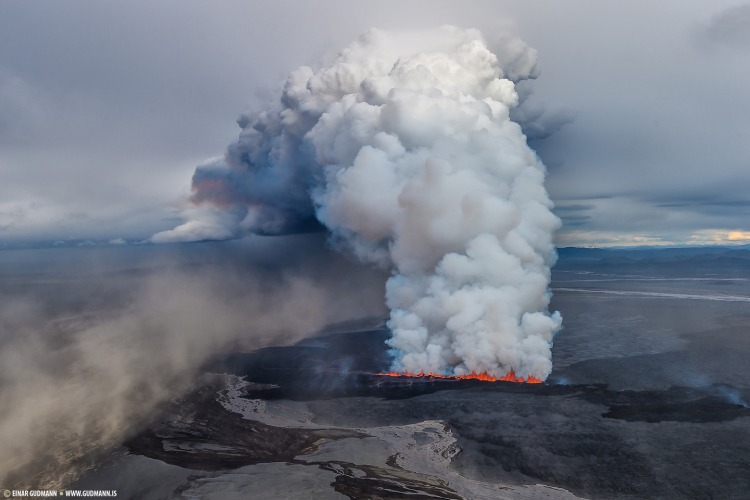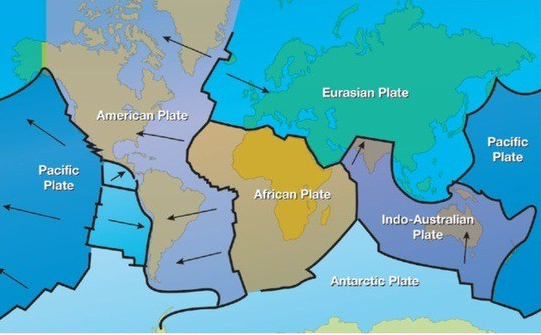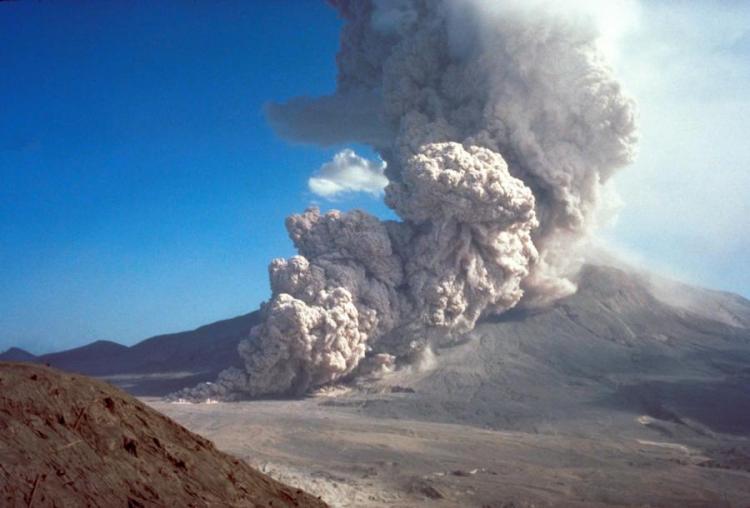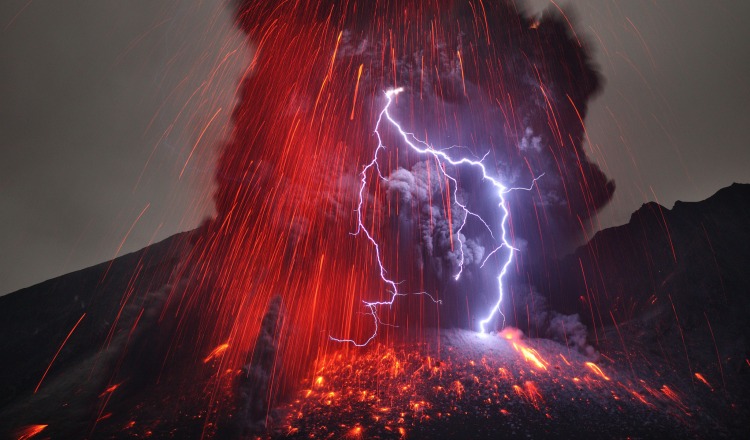So if you’ve read my blog before, you know that I’m in no way a volcanologist… I’m a hydro-meteorologist. But I do have an interest in (read: obsession with) natural hazards of all different varieties, so over time I’m going to be writing a series of posts on various natural hazards. You can read my previous post about tornadoes (and storm chasing!) here, and in this post I’m going to talk a little bit about volcanoes!

Why, and how, do volcanoes form?
The first question, is how do volcanoes form in the first place? The theory of plate tectonics has been around since ~ the 1960s, although the idea of continental drift was first mentioned in 1912. The theory describes the movement of the lithosphere (which consists of the Earth’s crust and the upper part of the mantle) over the mantle, the second layer of the Earth between the molten core and the crust on which we live. The lithosphere is ~50-150km thick, and is made up of 7 major tectonic plates – these account for ~94% of the Earth’s surface, with many smaller plates making up the rest. There’s an interesting article with more information on this here.

As the Earth’s tectonic plates move around, they can move away from each other, or collide – at which point one will move beneath the other (subduction), or they will sort of crumple together, forming mountain ranges. It’s when the plates move apart or subduct that we get volcanic activity! When the plates move away from each other, the molten magma from the mantle below flows out to effectively fill in the gap, and form a new crust. When a continental and oceanic plate collide, the oceanic plate subducts beneath the continental plate, and can be forced down to depths of up to 160km, where the heat causes the crust to release any trapped liquids, which then results in the formation of magma. Chains of volcanoes can often be formed along subduction zones, and these types of volcanoes (often stratovolcanoes, in particular) have been known to explode due to the gasses trapped inside building pressure until it can no longer be contained, e.g. the famous Mt St Helens eruption in 1980.
Photos taken by climbers atop Mt. Adams when #MtStHelens erupted on May 18, 1980. pic.twitter.com/5XXZfUaXOQ
— Mount St. Helens (@MtStHelensNVM) May 18, 2018
What’s the difference between active, dormant & extinct volcanoes?
You’ll often hear volcanoes labelled as active, dormant or extint – but what’s the difference? Active volcanoes are those that have erupted since the last ice age, so in the past ~10,000 years, whereas dormant volcanoes have not erupted in the past ~10,000 years, but are expected to erupt again in the future. Extinct volcanoes are those which are not expected to erupt again.
What are the most dangerous volcanic hazards?
There’s no denying that while fascinating, the idea of a volcanic eruption is pretty scary – volcanoes are capable of doing a lot of damage, and there are various hazards associated with volcanic eruptions, all of which can be dangerous. So what are they?
Perhaps the most obvious volcanic hazard is lava flow – when magma flows out of a volcano and reaches the surface, such as what’s been happening at Hawaii’s Kilauea volcano. Typically, lava flows are not very fast, you could probably outrun them on foot, but that doesn’t mean they’re not dangerous – with temperatures of 1000-2000°C, you definitely wouldn’t want to be in its way!
— Mt. Kilauea (@KilaueaMountain) May 22, 2018
Pyroclastic flows are one of the deadliest volcanic hazards, and often considered the most dangerous. Very different from lava flows, pyroclastic flows consist of rock, ash and gases which surge away from a volcano during an explosive eruption. They’re driven by gravity, but that doesn’t mean they’ll be confined to valleys – they can quite easily climb up and over hills and ridges! These flows often travel at speeds of hundreds of kilometres an hour, with speeds observed of up to 700kmh in the past. And on top of that, their temperatures are often in the range of 200-800°C, with some exceeding 1000°C. It’s this volcanic hazard which devastated Pompeii when Vesuvius erupted in the year 79, and which has caused destruction just this week during the eruption of Guatemala’s Fuego volcano.

Another type of dangerous flow from a volcano is lahars, which are mudflows formed by the mixing of volcanic debris and water, for example when a volcanic eruption melts snow and ice, when heavy rain falls onto volcanic debris, or when a volcano erupts through a lake. While not as hot as pyroclastic flows, lahars can still reach 60-70°C, and flow at speeds of 80kmh.
Tephra falls covers anything that falls to the ground after an eruption – from ash to larger projectiles. Obviously, larger pieces of debris can cause damage when they fall, and ash can cause problems if it settles in thick layers, which can bring down the rooves of buildings and power lines and disrupt infrastructure, and cause agricultural damage, alongside the potential to clog the lungs if too much is inhaled.
Volcanoes can also release toxic gases such as carbon dioxide, carbon monoxide, sulfur oxides, hydrogen sulfide, chlorine, and fluorine. These can be dangerous to human health, and destroy vegetation and even some metals. And finally, volcanic eruptions have been known to cause tsunamis in the past, if water becomes displaced by volcanic debris or pyroclastic flows, but more on tsunamis another time…
Read more on these volcanic hazards here and here.
Do volcanic eruptions affect the weather?
As a meteorologist, this is one question that particularly interests me, and that I’ve been asked a few times recently since volcanic eruptions have been in the news. And it is true that volcanic eruptions can affect the weather, and indeed the climate. Most people tend to think of large historic eruptions which have been said to cool the Earth. Very large eruptions such as Pinatubo, while rare, released lots of small particles into the upper atmosphere. These small particles had the effect of reflecting some of the incoming solar radiation back into space, which caused an overall cooling of the Earth of 0.5°C. While this doesn’t sound like much, and you may not notice it yourself, it can have a knock-on effect on atmospheric circulation, and therefore where and when storms and rainfall occur.
On a more local scale, a volcanic eruption can also affect the weather in it’s immediate vicinity. The ash released into the air acts as cloud condensation nuclei – the particles required for raindrops to form, meaning there can be increased rainfall around some volcanic eruptions. When volcanoes produce ash clouds, the friction between the particles of ash can cause an electrical charge and lead to volcanic lightning, such as during the eruption of Iceland’s Eyjafjallajökull volcano.

So while I did study other natural hazards as part of my meteorology degree, I in no way claim to be a volcanologist. If you, the reader, happen to be a volcanologist and would like to add anything to this post, please do comment below because I’m always eager to learn more about the science of all natural hazards!

Love this post! I’m currently doing a MSc in Geophysical Hazards and want to go into volcanology after and this post is a great intro to volcanoes! One hazard that is forgotten about is ballistics, which are the larger pieces of rock that are ejected from the vent! I did my undergrad dissertation on volcanoes and climate change and I loved it! I really wanna do a PhD in it so fingers crossed!
Liz x
naturalhazardsandmore.wordpress.com
LikeLiked by 1 person
Hi Liz – wow, your MSc and dissertation topic both sound brilliant! I’d love to learn more about volcanoes and climate change, do you have any papers or reading you’d recommend? And that’s true, I haven’t read much about ballistics! Does this come under the tephra category or would it be a different type of hazard? I wish you all the best for your plan to do a PhD in volcanology – I think that would be fascinating research! 🙂
Rebecca
LikeLiked by 1 person
They are fab, I love it! There’s a few papers by Bill Mcguire that talk about climate change and volcanoes, but I always search for SO2 changes and that should bring up papers to do with volcanoes and climate change 🙂 it is under the branch of tephra, as it is ejected from the vent, however I like to keep them separate as they can be so dangerous! Thank you so much, I want to do it now but I know I can’t just yet! Liz x
LikeLike
Ah fantastic, I’ll have to have a search soon and read more about it, thank you! Rebecca
LikeLiked by 1 person